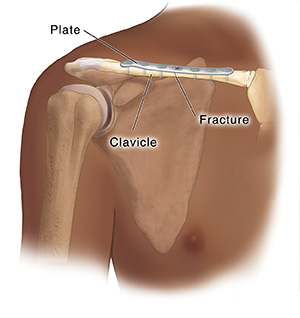Open reduction and internal fixation (ORIF) is a type of treatment to fix a broken bone. It puts the pieces of a broken bone back together so they can heal. Open reduction means the bones are put back in place during a surgery through a cut (incision). Internal fixation means that special hardware is used to hold the bone pieces together. This helps the bone heal correctly. The procedure is done by an orthopedic surgeon. This is a health care provider with special training in treating bone, joint, and muscle problems.
What is a clavicle fracture?
The clavicle is a long, thin bone located between your ribcage and the shoulder blade. You have 1 clavicle bone on each side of your neck. These are also called the collarbones.
Different kinds of injury can damage a clavicle bone, causing it to fracture into 2 or more pieces. Most often, this happens along the middle of the bone. The bone may also break near where it joins the ribcage. Or it may break near where it joins the shoulder blade. A clavicle fracture is most often caused by a direct hit to the shoulder. This may happen during a car accident or sports injury. Falling on an outstretched arm can also cause a clavicle fracture. Weak and brittle bones (osteoporosis) can make a clavicle fracture more likely.
In some cases, the bone may break but the pieces are still lined up correctly. When the pieces are not lined up correctly, it's called a displaced fracture. This type of injury may need ORIF to repair. Without ORIF, your broken clavicle may not heal correctly. During an open reduction, the bone pieces are lined up correctly again. The bones are then connected back in place with hardware. This is called internal fixation. The hardware may include screws, plates, rods, wires, or nails.
A clavicle fracture can often be treated with pain medicine and a splint or sling. But you are more likely to need ORIF for a clavicle fracture if:
-
The pieces of your broken bone are not lined up correctly.
-
Your broken bone went through your skin or your broken bone is pushing the skin out into a tent formation.
-
Your bone broke into several pieces.
How is clavicle fracture ORIF done?
An orthopedic surgeon will do the surgery with a team of specialized nurses and other health care providers. The surgeon will make a cut (incision) through the skin and muscle around your clavicle. The pieces of your broken clavicle bones will be put back into place (reduction). The pieces of bones will be secured to each other (fixation). This may be done with screws, metal plates, wires, or pins.
What are the risks of clavicle fracture ORIF?
All surgery has risks. The risks of clavicle fracture ORIF include:
-
Infection.
-
Damage to an artery or vein.
-
Injury to the lung.
-
Nerve damage.
-
Bone healing out of line or not healing.
-
Problems from anesthesia.
-
Need for more surgery.
-
Broken screws or plates or irritation from the hardware.
Your risks vary based on your age and general health. For example, if you are a smoker or if your bones are weak (low bone density), you may have a higher risk of certain problems. People with diabetes may also have a higher risk of problems. Talk with your provider about which risks apply most to you.


